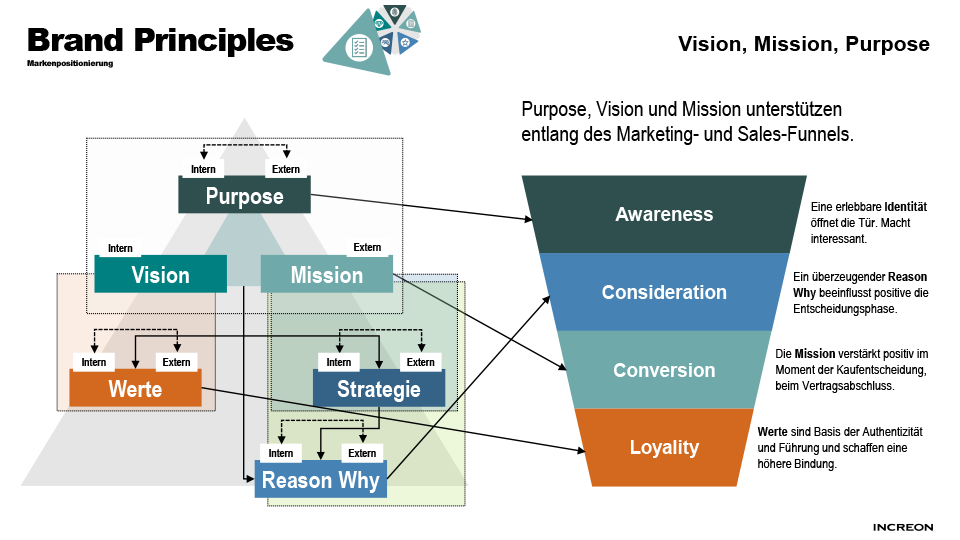Purpose, Vision, Mission
Are brand purpose and company purpose the same thing? Why do you need vision and mission? Can you manage a company and a B2B brand without answering these questions? Sure, you can. However, if employees, customers, and all other stakeholders understand and experience what a brand stands for, this has a motivating, inspiring, and sales-promoting effect.


PURPOSE, VISION, MISSION.
Work with motivation today on tomorrow.
In the past, entrepreneurs and businesses were a natural part of society. Responsibility for the community and the community’s dependence on local companies and employers created an interaction and made each other mutually responsible. In today’s international and hierarchical corporate structures, different communication tools are needed to convey the company’s purpose, future image, and mission to the diverse stakeholder groups. In brand consulting, we work with clients to develop the appropriate tools so that managers at all locations and levels describe the same vision and mission, and tell the same stories. This creates a holistic and credible corporate image, in which the relationship to society and responsibility for the community also form an essential part.
What is purpose?
Brand consulting differentiates. The corporate purpose is economic: it formulates economic goals that ensure the continued existence of the company. The brand purpose describes what lies behind the corporate goals: the meaning, the drive, and the motivation for long-term action. It places the B2B brand with its economic goals in a social, ecological, and ethical context. The brand purpose answers the question of co-responsibility, which is of great importance in employer branding today. For sustainable success, the long-term economic corporate purpose must also be encompassed by meaning and drive, by enthusiasm for the task itself and responsibility for society. In consulting projects, the aim is to work out and formulate this core.
Purpose — more than a buzzword
If the image in the market is different from what you want as a company or brand, expensive image campaigns in B2B markets will help temporarily at best. If a B2B company really wants to develop further, it has to face the question of its identity from within and start brand work there. The brand purpose provides some of the answers.
The future image of the company. The desired goal.
Vision — the view into the future
The vision describes a desired goal in the future — an ideal state that a company wishes to achieve. The vision must be ambitious, but in no way unattainable and therefore implausible. The vision reaches employees and stakeholders effectively if it is as concise as possible. Formulated in the present tense, the vision statement unfolds its potential even better, because it brings the future linguistically into the present. This makes the vision seem more achievable, closer, and more realistic. The present tense formulation causes the imagination to grow, which is important to us in brand consulting and development. The shorter and easier to understand the vision statement is written, the clearer it becomes to all employees what it is about.
Corporate goals and corporate strategies are closely linked to the vision, to the company’s image of the future. The vision stands for the long-term development of the company. It answers questions: Why do we do what we do? How do we justify what we do? And for whom are we doing it? The vision is the guiding framework for sustainable success if it is truly pragmatic, adhered to by all managers, and has a real connection to everyday actions.

Christina Bastl
Brand Consulting
Let’s talk about the importance of purpose, vision and mission along the marketing and sales funnel…
The mission of the company. What problems it solves and how.
Mission — working on the future today
The mission outlines the mission that the company is pursuing. It formulates why the company exists, how it works every day to fulfill the vision of the future, what makes it special, and what its unique selling proposition is. The mission statement also says something about what the company values in its daily work, in its mission and in its dealings with employees, customers, and stakeholders.
Values are exactly what address the market and the customers. The mission statement establishes the link between inside and outside because it explains how the company wants to be seen by customers, and why customers can trust it and be loyal. The clearer and more aware all internal stakeholders are of the long-term corporate mission and the shared values of the work, the more benefit the vision and mission unfold in the work and create a unified understanding. In brand projects, the first part of the brand work is done here, then it continues in brand consulting with the topics of brand identity, brand personality, brand values. And it branches out further into brand design and brand presence, to employer branding or customer experience, for example.
Purpose, vision, and mission in the marketing funnel
What is that supposed to mean? Who needs it? Where does it appear in communication? These questions are easy to answer if you consider the interaction of all aspects of brand positioning in brand consulting.
Brand purpose and vision dominate the awareness phase. They provide a quick insight into what drives the B2B company. This is interesting, arouses curiosity, and increases the time that a potential applicant or new customer spends looking at the company and its offering.
A “reason why” which is formulated in a convincing and concise manner has a positive influence on the consideration phase. In just a few words, it becomes clear what benefits the company promises and with what ambition it approaches its activities. In the conversion phase, the mission statement positively reinforces the purchase decision and the conclusion of the contract. Of course, it is not just the written words, but the congruent behavior of all employees in the company that gives the customer a secure feeling in their decision. Values are the basis. A common understanding of values leads to the same behavior of all players in the company and thus to an authentic image. The positive result is greater loyalty.







